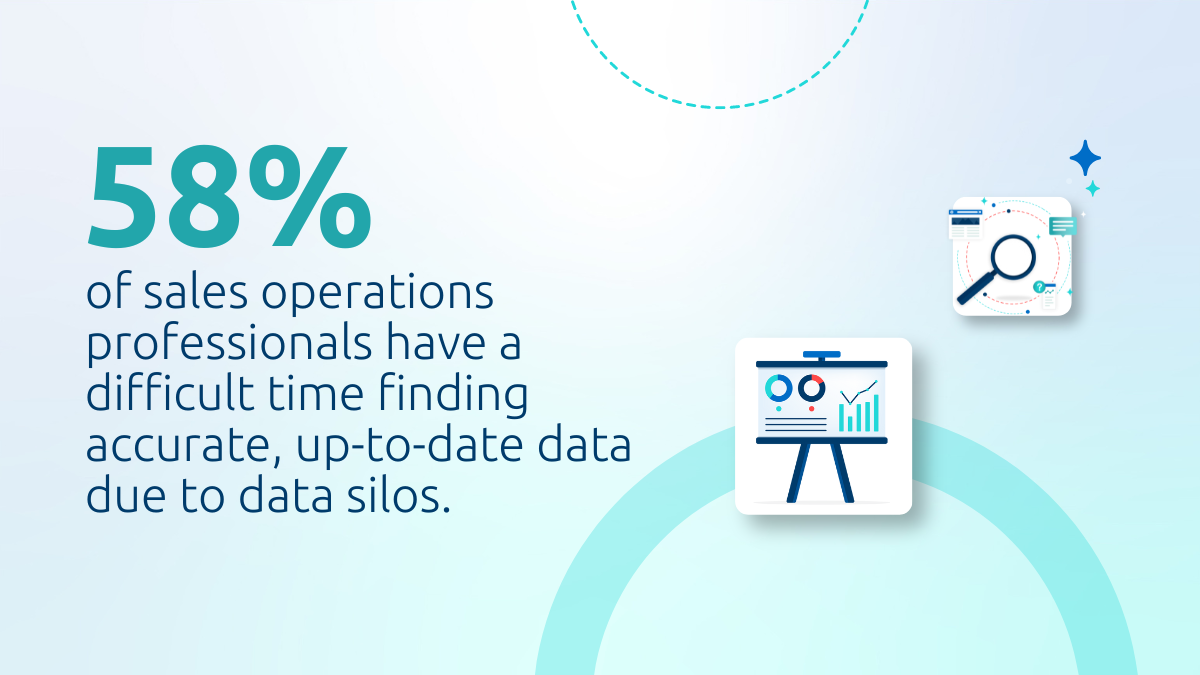Sales operations teams frequently encounter hurdles such as juggling too many tasks, outdated procedures, insufficient data management, and communication breakdowns. When sales performance starts slipping, it’s a call to action for a sales operations strategy makeover.
Read on for practical tips to supercharge your sales ops and turn obstacles into opportunities for revenue growth.
- The Important Role of Sales Operations
- Common Problems With Sales Operations
- Practical Tips to Improve Sales Operations
- Supercharge Sales Operations With Highspot
The Important Role of Sales Operations
Sales operations (sales ops) works to ensure the sales team functions smoothly. They oversee behind-the-scenes activities and administrative tasks so sales reps can focus on lead generation and closing deals. Sales ops streamline sales processes, manage sales technology, monitor sales metrics and dashboards, and align sales strategies with business priorities.
By working closely with stakeholders across the organisation, sales operations enhances sales success, improves customer relationships, and significantly impacts the company’s profitability.
Common Problems With Sales Operations
Operations teams are busier than ever. From managing evolving sales technology to responding to the changing pricing strategies and expectations of business leaders and customers, there is an endless demand for attention and action.
Let’s look at the common hurdles that sales operations teams encounter:
Juggling Competing Priorities
Sales operations managers face a whirlwind of duties and the challenge of wearing too many hats. This can lead to prioritisation issues, where critical tasks are dismissed in favour of seemingly urgent but less important activities.
Shifting Customer Expectations
Digitised selling has changed customer-business interactions. Modern customers expect personalised, connected experiences across multiple channels, from online to in-person. This creates complexities for companies that are not easily solved.
Maintaining communication cohesion across all touchpoints is a struggle without proper solutions. As a result, data silos emerge. A LinkedIn report shows that 58% of sales ops professionals have a difficult time finding accurate, up-to-date data due to data silos.
Additionally, there’s the challenge of adapting business processes to the needs of diverse customers, complicating the desire for a unified customer experience. For businesses to thrive, they must fully understand customer needs to deliver tailored experiences.

Source: LinkedIn
Keeping Up With Evolving Sales Technology
The rapid advancement of tech challenges sales operations to remain current. This constant evolution requires sales ops teams to endlessly evaluate and modify their tech stack to secure the most innovative solutions. Failing to keep pace can impact the sales cycle, resulting in missed opportunities and competitive losses.
Forecast Inaccuracy
Sales ops is responsible for ensuring sales forecast accuracy. Forecasting predicts future sales volumes over a period. To do this, they analyse sales data, market trends, and historical performance. The forecast guides budget, staff, inventory, and other operational decisions. An inaccurate sales forecast can have significant consequences.
For example:
- Misaligned resources: An overestimated forecast can lead to excess inventory and underutilised staff, whereas an underestimated forecast might result in inventory shortages and insufficient staff to meet customer demand.
- Missed opportunities: Inaccurate forecasts can cause sales teams to miss out on potential sales opportunities due to a lack of preparedness or to pursue unrealistic sales targets, wasting effort and resources.
Communication Barriers
Communication is complex in busy organisations, especially when misalignment between teams or the team-to-team or peer-to-peer handoff is not working well. Information is lost, follow-up is delayed, and the entire sales ops process is disrupted.
Manual Processes and Disconnected Systems
Manual processes and disparate systems can slow things down and introduce inefficiencies. This often leads to data entry mistakes, unreliable insights for making decisions, mix-ups when handing over tasks, and inaccurate forecasts.
Lack of Visibility Into Sales Metrics
Without real-time, accurate sales metrics, decision-making is guesswork that hinders growth. Ops leaders cannot evaluate the business’s performance or identify improvement areas. This gap can lead to misused resources, investing too much in poorly performing areas while neglecting those with potential.
A lack of visibility into these metrics makes it difficult to set goals, which can demotivate the sales team or set them up for failure. Inadequate visibility into sales metrics can complicate compliance efforts and lead to legal or financial repercussions. Teams waste time gathering data manually, reconciling discrepancies, and making decisions based on outdated or incomplete information, leading to delays and increased costs.
Practical Tips to Improve Sales Operations
Dealing with the complexities of change management and overcoming resistance requires simple, practical solutions. We’ll talk about how good leadership, special sales incentives, and clear jobs can help make sales ops better.
1. Strengthen Leadership Skills
Implement development programmes for sales leaders. Focus on strategic thinking, problem-solving, sales tools, and communication to guide sales ops through challenges and foster a culture of continuous improvement.
2. Streamline Sales Processes
Conduct regular audits of sales processes to identify and eliminate tasks that do not directly contribute to sales outcomes, such as process bottlenecks, redundant data entry, or unnecessary meetings.
3. Implement Proactive Management Practices
Be vigilant in identifying negative trends before they lead to losses and avoid short-term fixes in favour of sustainable solutions.
Imagine sales ops identifies a decline in quarterly sales for two quarters, traced through metrics like lead conversion rates and win rate. Data analysis reveals a drop in the conversion rate due to a new competitor’s lower-priced solutions. A root cause analysis shows the sales team needs better materials for competitive positioning. The company responds with a targeted sales training program to enhance negotiation skills and product differentiation. Sales ops closely monitor sales productivity post-training, evaluating the interventions’ impact.
The proactive approach allows the company to reverse the declining sales trend.
4. Personalise Sales Incentives
Sales ops teams, with their access to sales data and analytics tools, are uniquely positioned to transform incentive programmes. They are primarily responsible for ensuring that the sales infrastructure, processes, and strategies are aligned. This responsibility includes working on incentives that motivate and reward sales personnel for their performance.
5. Invest in the Right Tools
Invest in integrated tools that centralises data and automates tasks, such as CRM systems, sales enablement analytics and automation tools, and AI. These tools help break down silos, automate manual tasks, and provide valuable data that can lead to new sales. Sales reps can spend more time selling and less time searching for and entering data.
A prime example of the impact of integrated platforms comes from Oxford University Press’s experience with Highspot. Highspot equipped the sales team with interactive, readily accessible product information integrated into their daily workflows and tools. The integration with Salesforce was essential, a fundamental tool for their sales reps. As Lisa McCarthy, Director of Sales Operations at Oxford University Press, highlighted, integrating Highspot with Salesforce was a game-changer, offering a unified source of truth and significantly streamlining sales workflows.
6. Promote Cross-Functional Collaboration
By acting as a central hub that connects different departments, sales ops ensures that the sales strategy is well-coordinated with other business units. Aligning sales with marketing, finance, product development, and customer service fosters a more unified execution of sales activities.
7. Define Sales Ops vs. Sales Enablement Roles
Define clear roles and responsibilities for sales operations and sales enablement. Each team must have distinct objectives and metrics for success while setting up regular collaboration meetings to align strategies and share insights.
Recognising the difference between sales operations and enablement allows each function to specialise and excel in its respective area. Focus on defining sales operations as the backbone of the sales organisation that handles strategic sales planning, analytics, CRM management, forecasting, and internal processes. This team is responsible for the infrastructure that supports sales activities, ensuring that sales departments have the data, tools, and processes needed to operate.
Then, position sales enablement as the function dedicated to empowering sales professionals. This includes training and development programmes, content creation (like messaging, sales playbooks, and case studies), tools for engaging prospects and customers, and strategies for improving sales conversations and conversions. Even though the roles are distinct, ensure regular touchpoints for teams to collaborate.
8. Cultivate Continuous Learning
Develop a structured training and coaching programme that covers the latest sales methodologies, product knowledge, and customer engagement strategies. Host regular refreshers and assessments for team members to ensure skills remain current and buyer conversations are relevant.
9. Align Strategic and Tactical Objectives
Document a plan that breaks high-level business goals into smaller initiatives that teams and individuals can complete and measure.
Here’s a breakdown of what this looks like:
- High-level plans and goals: Broad, long-term objectives set by senior leadership to guide the organisation’s direction, such as increasing market share or achieving revenue thresholds, which dictate resource allocation across the company.
- Low-level plans and goals: Specific, short-term plans focusing on daily operations and immediate actions, like meeting sales targets or launching marketing campaigns, with an emphasis on execution details and operational tasks.
10. Standardise Sales Operations Function
Implement standard operating procedures and sales playbooks that outline the sales process, simplify complex tasks, and standardise best practices across the team to improve cross-departmental collaboration. A robust feedback loop within internal teams and with customers allows for collecting valuable information and pinpointing enhancement opportunities.
11. Optimise Performance Management
Develop a comprehensive performance management framework that includes setting clear sales goals, tracking performance through key metrics, and establishing accountability mechanisms. Couple this with regular feedback and coaching sessions to align sales operations with business objectives and enhance outcomes.
For example, define sales readiness metrics during new rep onboarding. Measure and reward success, but also monitor trends to identify training gaps or new opportunities. Provide sales management with information for data-informed coaching, mentoring, and process adjustments.
Supercharge Sales Operations With Highspot
Understanding the symbiotic relationship between sales operations and enablement is fundamental to sales success. Jo Stewart from Micro Focus points out that aligning sales strategies with operational goals and KPIs is essential. This alignment is where Highspot shines, seamlessly integrating sales enablement into sales operations to make salespeople successful.
With Highspot, organisations can turn sales ops challenges into business growth opportunities. Request a demo today.




